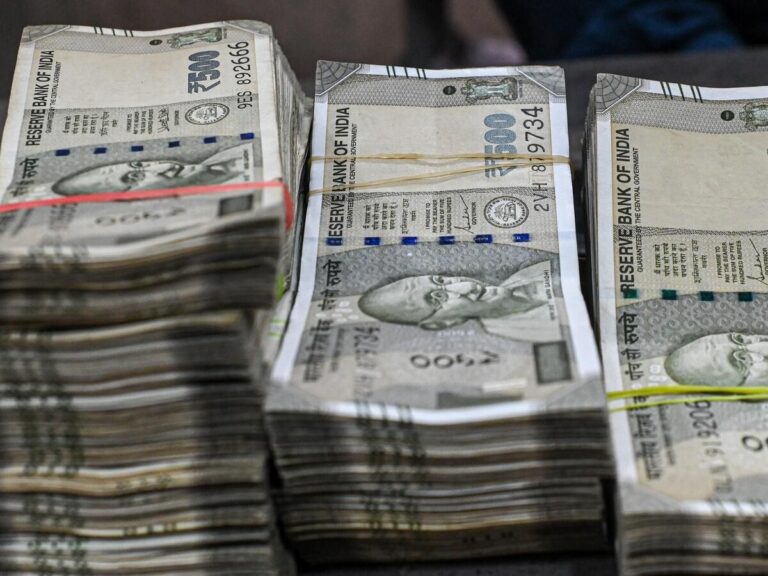The Indian rupee is poised to closely follow the trajectory of the U.S. dollar amid ongoing shifts in global currency markets, while domestic bond investors turn their attention to emerging expectations of interest rate cuts. As the dollar shows signs of recovery, analysts and traders are watching how these movements could influence the rupee’s performance, with the bond market increasingly pricing in potential easing by the Reserve Bank of India. This interplay between foreign exchange dynamics and monetary policy bets is setting the stage for a crucial period in India’s financial landscape.
Indian Rupee Poised to Mirror US Dollar Recovery Amid Global Market Sentiments
The Indian rupee is showing signs of aligning closely with the US dollar’s recent recovery, driven by shifting global market sentiments and improving economic indicators. As investor confidence strengthens, the local currency is anticipated to benefit from a broader risk-on environment where capital flows to emerging markets increase. Analysts highlight that the rupee’s trajectory will largely depend on the dollar’s strength amid ongoing geopolitical developments and central bank policy expectations in the United States.
Meanwhile, bond markets in India are sharpening their focus on the prospects of an imminent rate cut by the Reserve Bank of India. Traders are scrutinizing economic data for signs of easing inflation and stable growth to gauge the likelihood and timing of monetary easing. Key factors influencing the bond yields include:
- Inflation trends and core CPI readings
- Fiscal deficit management and government borrowing plans
- Global commodity price fluctuations
- US Federal Reserve’s next policy moves
| Indicator | Current Status | Market Implication |
|---|---|---|
| USD/INR Exchange Rate | 74.50 | Supports rupee gains if dollar pressure eases |
| 10-Year Bond Yield | 7.1% | Reflecting rate cut anticipation |
| Inflation (CPI) | 5.8% | Key determinant for RBI’s policy stance |
Bond Market Eyes Upcoming Rate Cut Signals as Inflation Pressures Ease
As inflation pressures show signs of easing, investors in the bond market are increasingly anticipating signals from the Reserve Bank of India (RBI) indicating potential rate cuts. This shift is shaping trading strategies, with yields on government securities experiencing notable declines amid expectations that borrowing costs may be lowered to support economic growth. Market participants are weighing recent inflation data alongside RBI’s communications, seeking clear indicators on the timing and scale of possible policy easing.
- Government Bond Yields: Trending downward, reflecting easing inflation concerns
- Inflation Metrics: Consumer Price Index showing slower rise in recent months
- Economic Growth Forecasts: Moderate optimism driving demand for lower interest rates
- Rupee Movement: Tracking the US dollar’s strength, adding complexity to RBI’s policy decisions
| Indicator | Current Value | Previous Month | Change |
|---|---|---|---|
| 10-Year Government Bond Yield | 6.45% | 6.60% | â–Ľ 0.15% |
| Consumer Price Index (YoY) | 5.2% | 5.7% | â–Ľ 0.5% |
| USD/INR Exchange Rate | 82.35 | 82.10 | â–˛ 0.25 |
Strategists suggest that while the bond market is positioned for a gradual normalization in rates, external factors such as global dollar strength and geopolitical developments remain critical. The rupee’s fluctuations against the dollar could influence RBI’s urgency to adjust monetary policy, balancing inflation control with currency stability. With central banks worldwide navigating trade-offs, India’s bond market is becoming a focal point for investors parsing nuanced signals for future rate direction.
Strategic Recommendations for Investors Navigating Currency Fluctuations and Interest Rate Expectations
Investors should closely monitor the interplay between the Indian rupee and the US dollar, as the rupee is poised to follow the dollar’s recovery trajectory amid global market uncertainty. Strategies that emphasize diversification across currencies can help mitigate volatility risks. Specifically, focus on assets denominated in stable currencies while maintaining exposure to rupee-linked investments to benefit from potential currency appreciation. Additionally, hedging options such as currency futures or options can guard portfolios against sudden shifts caused by unexpected rate decisions or geopolitical developments.
In the bond market, anticipation around the Reserve Bank of India’s interest rate policies plays a pivotal role in shaping investment decisions. Yield-sensitive sectors may experience sharp movement depending on the timing and magnitude of any rate cuts. Investors are advised to consider short-duration bonds or floating rate instruments to navigate interest rate volatility efficiently. Below is a quick guide on recommended bond strategies based on rate expectations:
| Interest Rate Outlook | Investment Strategy | Risk Level |
|---|---|---|
| Rates Expected to Fall | Long-duration government bonds, bond ETFs | Moderate |
| Rates Stable | Short-duration bonds, high-quality corporate bonds | Low |
| Rates Expected to Rise | Floating rate debt, inflation-protected securities | Moderate to High |
- Stay alert to RBI announcements: sudden policy shifts can cause rapid market adjustments.
- Use currency hedges: to protect foreign investment returns against rupee volatility.
- Diversify across asset classes: blending equities, debt, and forex instruments to reduce portfolio risk.
Key Takeaways
As the Indian rupee continues to mirror the trajectory of the U.S. dollar, market participants remain closely attuned to global currency movements and their domestic implications. Meanwhile, bond investors are increasingly focused on policy signals from the Reserve Bank of India, weighing the likelihood and timing of potential rate cuts. These dynamics underscore the interconnectedness of currency and fixed-income markets as India navigates evolving external and internal economic conditions.




